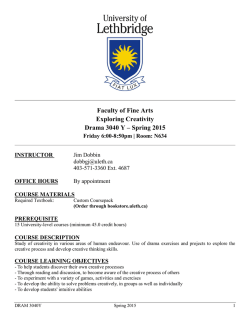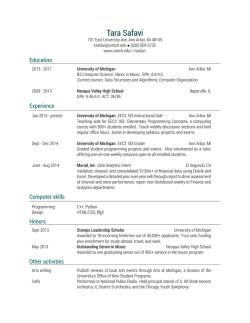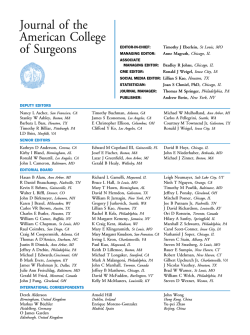
CREATIVITY AND STRATEGIC THINKING: THE COMING
CREATIVITY AND STRATEGIC THINKING: THE COMING COMPETENCIES Ann Herrmann-Nehdi, CEO Herrmann International 794 Buffalo Creek Road Lake Lure, NC 28746 www.hbdi.com SUMMARY Creativity and strategy are no longer optional in today’s rapidly changing business environment. Now considered essential to maintaining a competitive edge, many organizations are seeking ways to unleash new perspectives and fresh thinking about their products, markets, challenges and competitors. Understanding the thinking styles involved in the different phases of the creative and strategic thinking processes (not to mention the quality process) allow individuals and organizations to more effectively take advantage and apply the brain power available to them. BACKGROUND Every decade seems to provide us with a new era of management focus. The 60’s centered on systems and decentralization. In the 70’s we saw strategic business units emerge with the role of manager becoming primary. The TQM (Total Quality Management) movement came into view during the 80’s and continues to have a lasting impact on American business structure- measurements of customer satisfaction and quality control systems are now an integral part of most American businesses. Radical change and re-engineering seem to have permeated every aspect of our day to day business existence in this current decade. The focus on re-engineering business systems has distracted away from the core requirement that this new era of re-engineering requires. By its very definition, re-engineering requires re-invention, which cannot effectively occur without creativity and strategy. understanding of the source and nature of creative and strategic thinking is required. Our research on the brain and thinking has demonstrated that we all have access to these specialized thinking modes. Yet much of this thinking often lies dormant in our organization waiting to be unleashed. To paraphrase Charles Handy of the London School of Business (in Fortune, Oct 1991) when CEO’s were asked how much of the brainpower in their organization was actually used; the answer was 20%. Ned Herrmann, author of The Creative Brain puts it this way: “In the corporation of the future, new leaders will not be masters, but maestros. The leadership task will be to anticipate the signs of coming change, to inspire creativity, and to get the best ideas from everybody.” How is that accomplished? First and foremost a clear CREATIVITY AND STRATEGIC THINKING PAGE 1 ANN HERRMANN-NEHDI The key to tapping into the thinking potential of an individual or organization lies first in understanding the mentality of their day to day decision making process and what they pay most attention to. In order to determine what you pay most attention to, it can be helpful to look at the Whole Brain model shown below. The four quadrants describe different processing modes that we all have access to. However, we often prefer some of these modes over others. As you look over the model, reflect upon those descriptors that best characterize how you prefer to think. Our research has shown that the creative process and the strategic process use all of the above approaches but use them at different stages in the process. CREATIVITY: WHAT IS IT AND HOW IS IT DEVELOPED AND APPLIED? There continues to be a lot of mystique around the creative process. In fact, once creative thinking is understood as a series of thinking processes that can be applied and learned, it suddenly becomes available to us all. Some years ago our company was running Creative Problem Solving (CPS) programs for a large consumer product company’s ‘brand teams’ and their advertising agency counterparts. The ad agency team was uncomfortable because they felt that the CPS program was “demystifying” the creative process. Creativity was a domain that they were “expert” in and that they were getting paid a lot for. They were as yet unaware that the applied creative problem solving process they would learn would go beyond their definition of “creativity”. The ultimate outcome of the session was a greatly enhanced team process, alignment of team objectives (which provided significant savings of monies and time wasted on ‘misfires’), and a genuine respect for the different perspectives each of the team members brought to the table. An understanding of different styles is the foundation for any team or group wishing to work on problems creatively. First, individuals need to recognize the unique creative ability that resides within each of them and their preferred thinking styles. Due to their uniqueness and style, each individual will approach problems quite differently. Honoring different thinking approaches will allow every member of a team or group to share their thinking and ideas openly. Once that openness occurs, the team’s creativity begins to emerge, taking advantage of the different thinking styles, rather than experiencing them as obstacles. In light of the above, it is easy to understand why many of us learn and use creative problem solving tools that ‘fit’ our preferred thinking style. In team settings, groups can take advantage of the different styles, tools and skills by applying as many different tools and styles as possible to their given problem as a strategy to avoid getting “stuck” or stumped. For example, Brainstorming, a widely used idea generation technique, (which falls into the Upper Once the agency team was convinced they should attend the workshop, it became evident that all participants had a role to contribute to the creative problem solving process. Examples of issues that the group would work on included analysis of the problem/opportunity, customer input, breakthrough ideas, technical challenges, team facilitation issues, implementation, and follow up. All the different processes across the mental spectrum were required to successfully resolve those differing aspects of the problems at hand. CREATIVITY AND STRATEGIC THINKING PAGE 2 ANN HERRMANN-NEHDI Right D category of the whole brain model) certainly won’t appeal to everyone. This is why you often find people incorrectly using the technique, or wondering why it doesn’t produce the desired outcomes. Group members may feel frustrated or “stuck” in their own perspective. The solution is to explore other tools and strategies from all four quadrants. This allows all group members to see a value in their contribution and significantly increases the quality of the output. Members discover that when motivated, they can acquire skills and tools in areas outside of their preferences through practice and skill building. OUT OF THE BOX THINKING Perhaps it is because we get “stuck” that we sometimes call creative thinking “Out of the box thinking”. Clearly we appear to have an intuitive sense that each of us needs to “break out” of our natural thinking processes, to “get out of out our own box”. Understanding your brain dominance profile provides a new definition of the mental “boxes” or boundaries we may have created for ourselves. In fact, we each have a set of mental “defaults”. The brain is so efficient that as you develop thinking patterns that you repeat day after day, many may become your “defaults”. A default is where we go almost unconsciously when faced with a decision or challenge Once you know what your mental defaults may be, it is much easier to predict and define what your boundaries will be and thus the areas that will be a challenge for you to see differently. Our mental defaults impact all we do. Some defaults save our lives as we problem solve in emergency situations such CREATIVITY AND STRATEGIC THINKING as an oncoming automobile accident that we are able to avoid. As learners, we become comfortable and develop habits around our comforts zones and defaults. The following exercise is an example of a mental default. Read over the following list for 20 seconds, then turn away and on a separate piece of paper, without looking at the list, write down all the words you can remember. Bed Snooze Dream Snore Blanket Nap Bedspread Sheet Pillow Nightlight Now look at your list. How many did you remember? Did you write the word “sleep”? Many people do. When the brain sees words relating to sleep, it often “fills in the blanks” and goes to the associated default (in this case sleep) when it actually hasn’t seen the word at all. Other examples of mental defaults occur every time you face a problem to solve. Your first approach to a problem situation usually uses your “mental default” to try to come up with a result—often this is the way the problem might have been solved previously. A whole brain approach to creative thinking shifts you beyond that default to discover new ideas and potential solutions because you engage different thinking strategies and techniques. Often looked at a problem for so long that we don’t even realize that we are using our default. Case in point, a client was challenged because their packaging of large light fixtures caused costly breakage. Not only were the costs of the packaging and breakage skyrocketing, the materials used were difficult to recycle. The team was sure they had thought of every possible solution. Using whole brain creativity techniques to get “out of their box” they devised the idea of packaging the fixtures in garbage cans which were then resold. The recycling problem was solved, and costs dropped significantly as did the breakage, all because of “out of the box thinking” To get “out of your thinking box” it is first important to know what your thinking preferences and mental defaults are (often discovered by taking an assessment such as the Herrmann Brain Dominance Instrument or other assessment tools). Next look for ways to develop skills in areas of lesser preference: 1) 2) 3) 4) Find a mentor Engage colleagues who have different preferences in problem solving sessions Take a course Read one of the many books on creativity techniques, try out several and practice them PAGE 3 ANN HERRMANN-NEHDI Awareness of your own “box” is the first essential step! A commonly cited anonymous quote says it well: If you always do what you have always done, then you will always get what you have always gotten. This couldn’t be truer than for strategic planning departments. STRATEGIC THINKING VS. STRATEGIC PLANNING Whenever the word “strategic” is uttered, most people think of planning rather than thinking. They are very different animals indeed. Over the years, large organizations have relegated strategic plans to the planning department and inadvertently created a bureaucracy. Jack Welch, CEO of GE, described it this way: “ The (strategic plan) books got thicker, the printing got more sophisticated, the corners got harder, and the drawings got better”. Indeed the strategic planning process had become a bureaucracy that was an example of form becoming more important than substance. It has also been described as an approach typified as paralysis-byanalysis. once a year activity undertaken by a single group of senior managers and planners is becoming an iterative, continuous process that involves the entire organization.” So what is strategic thinking? Strategic thinking is a mindset that allows you to: 1) 2) 3) 4) 5) Anticipate future events and issues Create alternative scenarios Understand your options Decide on your objectives Determine the direction to achieve those objectives on a winning basis Once you have accomplished the latter, then a plan may be developed. Without a strategic thinking approach as the foundation, so-called strategic plans end up frequently becoming operational or tactical plans in disguise. To better understand the difference between an operational plan and a strategic plan we can once again look at the thinking style differences they each engage. The model below shows our four different selves from a thinking perspective. Strategic thinking calls for more D quadrant thinking. In contrast, operational thinking requires more B quadrant processes. Much has happened and been written in the field of strategic planning in recent years and several new theories are emerging in this decade. One axiom and lesson proves true again and again: Strategic thinking must precede strategic planning. Most organizations know a lot more about the planning part of that equation. Stephen and Shannon Rye Wall put it this way in The New Strategists Creating Leaders at all Levels: “Strategic Planning’s top-down flow and linear procedures are breaking down, just as the hierarchies of management are. What was once a structured, CREATIVITY AND STRATEGIC THINKING PAGE 4 ANN HERRMANN-NEHDI So how do you stimulate strategic thinking? Successful strategic thinking often involves environmental scanning. This process involves a “scan” of the key factors and general trends around the business that could have an impact on future results. Another important technique stimulates new thinking about key elements of the current business. for trends, as well looking at your customers in a new way by asking new questions. An example of this is described in the work of Gary Hamel and C.K. Prahalad who have explored issues of competitiveness in their ongoing research. They state in Competing for the Future that one of the greatest strategic challenges is to move beyond the focus of today. Every business that we work with has a good grasp on today’s business, One group or senior executives from a technical today’s customer needs and today’s customer types. product company was looking to determine how Hamel and Prahalad propose going their customer base might shift in the “good anticipation beyond today’s perspective to explore future. To help the group gain new those customer types we don’t yet perspective on their customers, they is the result of serve and those customer needs that first participated in an activity which good strategic have not yet been articulated. To used animal metaphors to describe accomplish this, you must first start key products, customers, distributors, exploration” by anticipating customer needs rather vendors, OEM’s (original equipment Joel Barker, The Future Edge. than reacting to those that have manufacturers) and competitors. already been articulated. Joel Barker Interestingly, all of the metaphors in The Future Edge says it this way: chosen by the group for the distributors we negative in nature. In fact, once the group started discussing the metaphors, they realized that the distributors were really considered more as an outlet for unused or unsold product, rather than a primary source of opportunity and income. Next the group scanned the environment for trends. The exercise revealed that all indicators showed that a large percentage of revenue would come from distributors in the future due to shifting trends. The metaphor exercise had already revealed to the group how negatively they regarded this key strategic customer, the distributors. “I go to “In times of turbulence, the ability to anticipate dramatically enhances your chance of success.” Strategic thinking requires an approach that anticipates rather than reacts. Rather than solving problems as they occur, this approach avoids problems before they occur and seeks out opportunities before they have become obvious to all in a given industry. To do this, you must think ahead to where you want to be, not where you are today. As the hockey player Wayne Gretsky puts it: “I go to where the puck will be”. where the puck will be” So how do you get to where the puck “will be?” Once again, your preferences will act as “filters” that have a great impact on your ability to think strategically. Some activities that promote a strategic mindset are: These activities initiated a shift in the group’s mindset about distributors, who now were seen as strategic Wayne Gretsky customers, not a place to dump excess product! The team immediately set about to develop 1) Looking at other industries and businesses… a specific strategy that focused on the distributor what can you learn from trends that impact marketplace and learned to look at them as key them? customers. 2) Joining associations like the World Future Society….this helps you stay informed of trends 3) Readng books on topics that may have an impact GAINING THE COMPETITIVE EDGE WITH YOUR CUSTOMERS on your business in the future but not today. BY ANTICIPATING NOT REACTING 4) Playing chess and thinking several moves ahead Much of this “shift in mindset” requires looking 5) Looking at your own “life plan” and visualizing outside the business and scanning your environment CREATIVITY AND STRATEGIC THINKING PAGE 5 ANN HERRMANN-NEHDI where you will be and what you will be doing in the year 2010. In short, “good anticipation is the result of good strategic exploration” Joel Barker, The Future Edge. bombardment of information and global perspective will demand that we all draw on all of our thinking skills. Most of all, each of us will need to tap into our situational brain power, our four different selves, as each event requires it, in order to optimize our contributions and become successful. HOW ABOUT QUALITY? Remember when the US imported the notion of Quality Circles from Japan’s Dr. Kauro Ishikawa in the 70’s? This approach, which was successfully implemented in Japan, did not achieve the same levels of success here in the US. An understanding of the brain, thinking styles and the mentality of quality can help explain what went wrong. Clearly the Japanese culture was able to integrate the left-brained quantitative aspects of the quality processes into the more right brained participative management culture. In our country, most companies were not yet ready to embrace the right-brained notions of participative management in the prevailing left brained culture. As Dr. Joan Cassidy puts it in her paper, “Learn to Create High Performing Teams”, “It was difficult for most managers to relinquish what had worked for them in the past…to give up control, work in groups and make decisions by consensus was anathema.” REFERENCE LIST Barker, Joel, The Future Edge, 1986 Cassidy, Joan, “From Half Brain to Whole Brain, Learn to create High Performing Teams”, 1998, article to be published Hamel, Gary, Prahalad, C.K, Competing for the Future, 1994. Herrmann, Ned, The Creative Brain, Brain Books, 1988 Herrmann, Ned, The Whole Brain Business Book, McGraw Hill, 1996 Stewart, Thomas, “Brain Power, Fortune”, Oct 1991 Wall, Stephen and Shannon Rye, The New Strategists, Creating Leaders at all Levels, 1996 Another interesting example emerged in the 80’s with the application of Deming’s approach (more whole brained) and Juran’s approach (a more structured left-brained approach). The impact of the different “mental” approaches meant that certain organizational cultures would favor one expert over the other. Without an understanding of the differences of the two approaches, organizations may be “blind” to the criteria of selection and effectiveness of one approach over another. CONCLUSION While the industrial age required a focus of structure and analysis to build our industries, it is evident that the digital era already provides the structure but now demands different thinking skills and more creative approaches than were ever required before. The rapidly changing environment, simultaneous CREATIVITY AND STRATEGIC THINKING PAGE 6 ANN HERRMANN-NEHDI
© Copyright 2025







